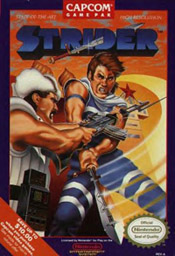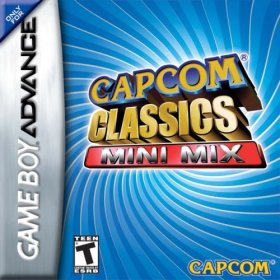Review | Screenshots | Concept Art | Merchandise | End Credits
Strider for the NES

The NES Strider began as one part of a three-way joint project between Capcom Japan and Moto Kikaku. The NES game's planner, Masahiko "Patariro" Kurokawa, worked closely with Moto Kikaku's illustrator Tatsumi Wada, developing a game that dovetailed well with Wada's Kadokawa Shoten-serialized manga. Unlike his colleague Isuke's coin-op, the NES game and the manga were of a piece, sharing concept art, characters, and plot elements.
Being developed alongside a serialized manga, the game's plotline is fairly involved, taking Hiryu to five different continents as it unfolds. It begins with a search for Hiryu's missing friend Kain, but quickly unfolds after the first stage, exposing a sinister plot at the heart of the Strider organization itself. The "cutscenes" that tell this story are nondescript with head-scratchingly-poor translation that gives Zero Wing a run for its money.
The most difficult part of this game is adjusting to the stiffness of the graphics. They're mediocre, only slightly above average for the NES... but they're not terrible. The real problem is the collision detection: it's way off. Pulling off a triangle jump is murder (thank god you only have to use it once), and avoiding enemy fire is tricky. A shot can pass three pixels below Hiryu's foot and he'll take damage. The smooth acrobatics of the coin-op are completely absent. Hiryu's cartwheel jump is gone, he doesn't tumble when hit, can't cling to walls (although he can obtain a pair of magnet boots that allow him to walk up them), and can't kill enemies by sliding into them until 80% of the way through the game. In fact, he can't even slide at the beginning of the game... it's a skill he acquires.
Despite these shortcomings, as an action/adventure version of Strider, it's not a bad game.
Mysteriously, though it was developed and even announced for the Famicom, this game was never released on that system. It was canceled, for reasons still unknown; American gamers saw an altered port late in 1989, amid the flurry of home ports of the coin-op. For years, no one knew that the NES game even had been altered, much less how. Then, in 2006, a beta surfaced on Yahoo! Japan, which Chris Covell bid on and lost (¥176,000 = $1500; a hefty price, no matter who you are). Undeterred, he posted the following video to the Internet Archive, a Japanese TV advert for the Famicom release that never was.
Astute readers will note several differences between the version in the commercial and the one familiar in the West. For example, in the commercial, conversations between Hiryu and NPCs take place on the game screen itself. In the NES version, the game cuts to a black screen, displays the text, and cuts back to the game. This is most likely due to a sprite-based text routine in the Japanese version. Such routines were limited to eight characters per line, which was fine for kanji but not for alphabets, hence the cuts to and from black screens.
 These small details and others (glitchy collision detection, the Engrishy translation, the insane amount of flicker) leads this reviewer to believe that the NES Strider is simply an unfinished, unpolished beta that Capcom released to capitalize on the coin-op's popularity.
These small details and others (glitchy collision detection, the Engrishy translation, the insane amount of flicker) leads this reviewer to believe that the NES Strider is simply an unfinished, unpolished beta that Capcom released to capitalize on the coin-op's popularity.
Ultimately, the NES Strider remains an entirely different experience, marred by the fact that it is, in all likelihood, an unfinished beta. Still, if you're in the mood for an action/adventure version of Strider, you'll find it included in the Capcom Classics Mini Mix collection for Game Boy Advance.
Further Reading
Review | Screenshots | Concept Art | Merchandise | End Credits